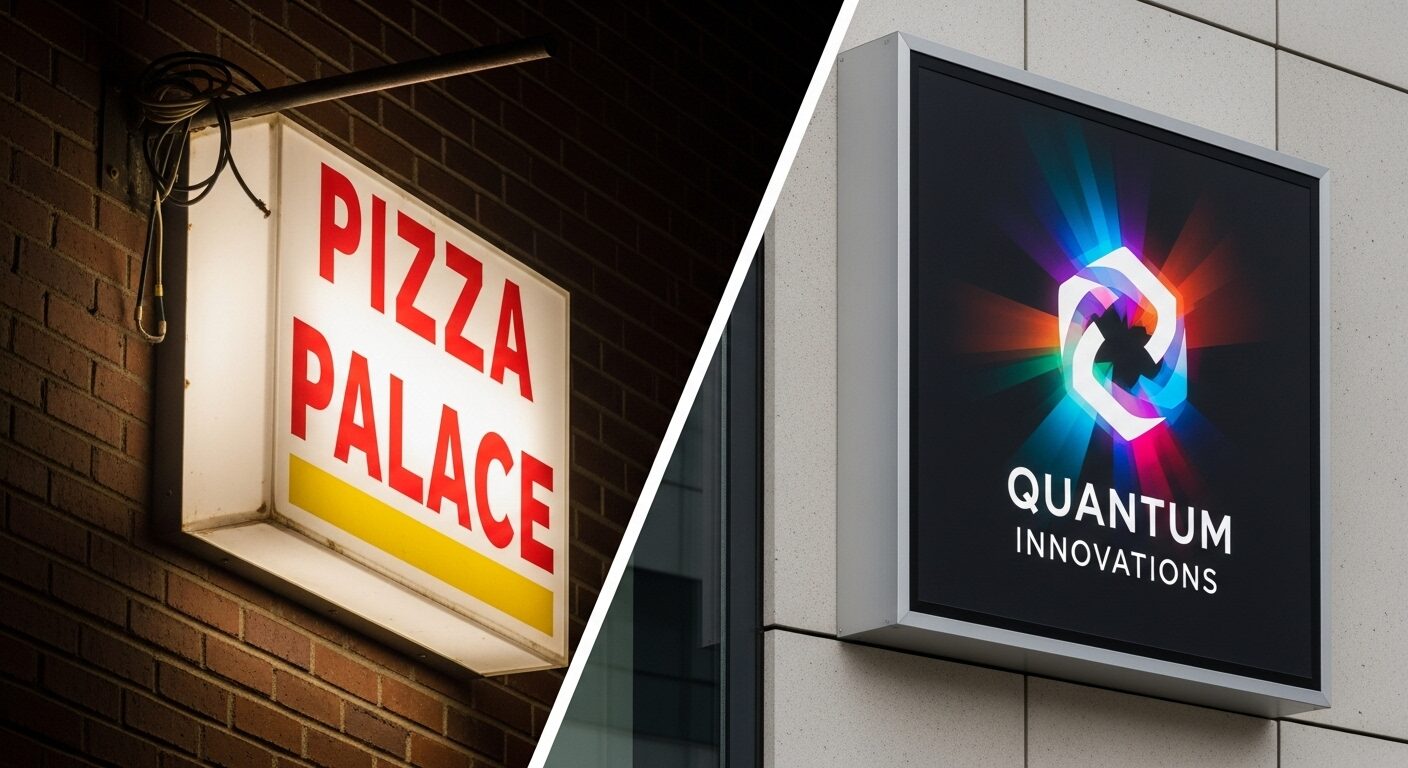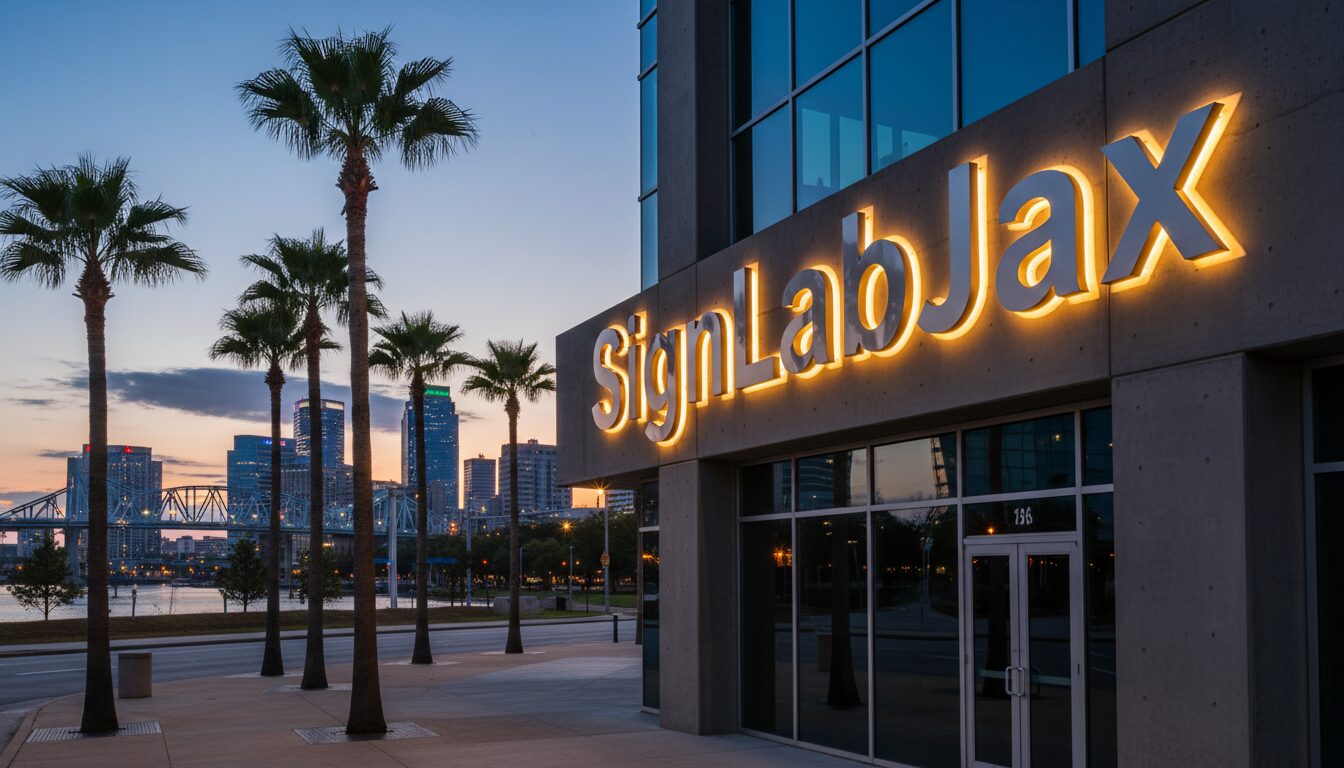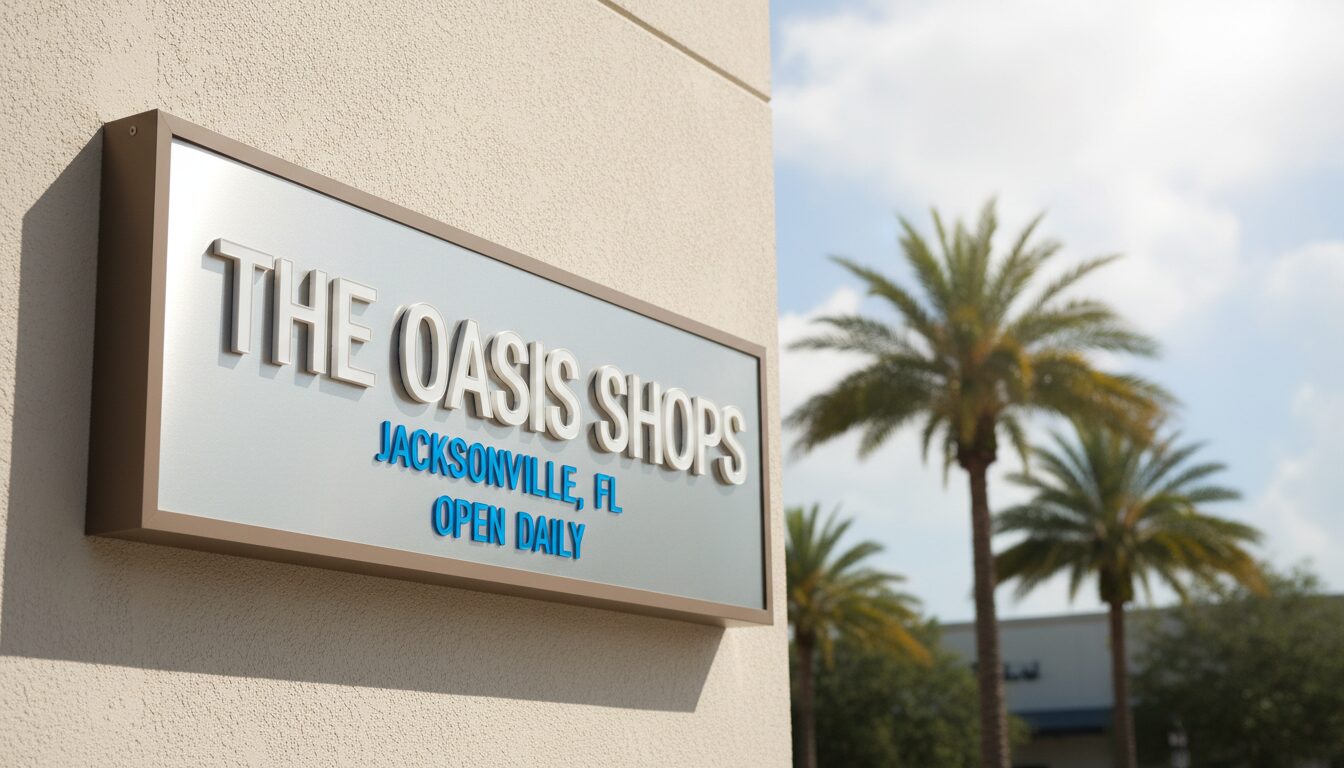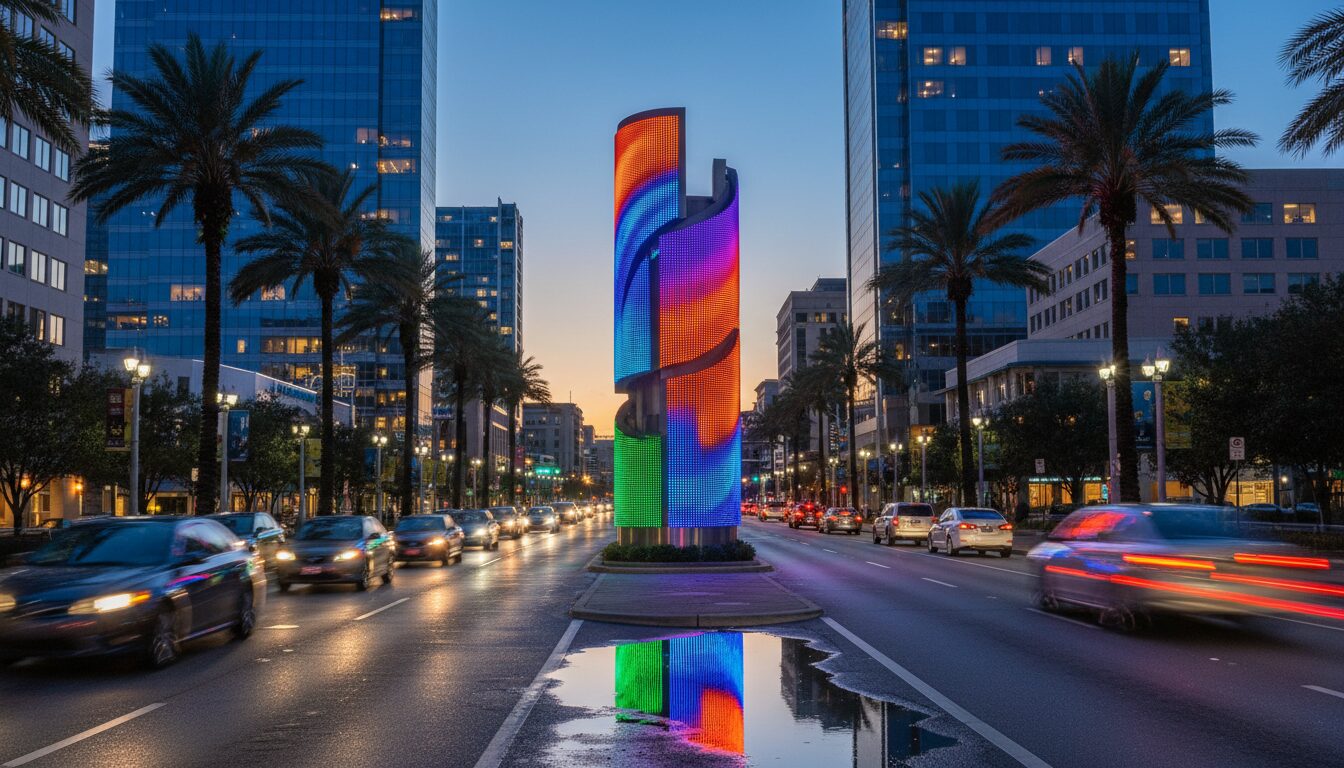The business signage industry is experiencing its most significant transformation in decades. As we progress through 2025, fundamental shifts in technology, materials, consumer expectations, and environmental consciousness are reshaping how businesses approach sign design and implementation.
These changes aren’t superficial design trends – they represent strategic adaptations to evolving market conditions, technological capabilities, and business requirements. From manufacturing processes to customer interaction methods, every aspect of business signage is being reimagined to meet contemporary demands while preparing for future challenges.
Understanding these changes helps business owners make informed decisions about their signage investments, ensuring their choices align with current capabilities while maintaining relevance for years to come. Whether you’re planning new signage or evaluating existing installations, recognizing these industry shifts provides valuable context for strategic decision-making.
Material Innovation: Beyond Traditional Options
The most fundamental change in business sign design involves the materials being used for construction and finishing. Traditional materials are being enhanced with new technologies, while entirely new material categories are entering mainstream commercial applications.
Advanced Composite Materials have revolutionized durability expectations for business signage. These engineered materials combine the best properties of multiple substances, creating signage components that resist weather damage, maintain color consistency, and provide structural integrity that surpasses traditional alternatives.
Modern composites address specific challenges that have historically plagued business signage. UV-resistant formulations prevent the fading and discoloration that previously required frequent replacement or refinishing. Moisture-resistant construction eliminates the warping and deterioration common with traditional materials in humid climates.
Sustainable Material Integration reflects growing environmental consciousness in business decision-making. Companies are increasingly requesting signage made from recycled materials, sustainably sourced components, and materials that can be recycled at the end of their useful life.
Bamboo-based materials are gaining popularity for interior applications, offering renewable sourcing with attractive natural aesthetics. Recycled aluminum and plastic composites provide environmental benefits while maintaining the durability and appearance requirements of commercial signage applications.
Smart Material Technologies introduce interactive capabilities directly into signage construction. These materials can change color in response to temperature variations, provide touch-sensitive surfaces, or incorporate conductive elements that enable electrical functionality without traditional wiring.
Thermochromic materials allow signage to change appearance based on ambient conditions, creating dynamic visual effects that capture attention while providing practical information about environmental conditions. Conductive substrates enable touch-sensitive areas that can trigger lighting effects or content changes.
Digital Integration: Beyond Simple Displays
Digital elements in business signage have evolved far beyond basic LED screens and message boards. Contemporary digital integration creates sophisticated communication platforms that blend seamlessly with traditional design elements while providing advanced functionality.
Hybrid Design Approaches combine traditional materials with digital components to create signage that maintains classical aesthetics while offering modern capabilities. These designs often incorporate small digital elements within larger traditional frameworks, providing the best of both approaches.
Architectural integration has become more sophisticated, with digital elements designed to complement rather than dominate traditional design elements. This approach appeals to businesses wanting modern capabilities without abandoning established brand aesthetics or architectural harmony.
Content Management Evolution has transformed how businesses approach digital signage operation. Modern systems provide intuitive interfaces that allow non-technical staff to update content, schedule messaging, and monitor performance without requiring specialized training or ongoing technical support.
Cloud-based management platforms enable remote operation from any location, allowing business owners to manage signage content across multiple locations or update messaging while traveling. Automated content systems can adjust displays based on time, weather, inventory levels, or other business conditions.
Interactive Technology Integration creates customer engagement opportunities that extend beyond traditional advertising functions. Touch-sensitive surfaces, motion detection, and smartphone integration transform signage from passive displays into active customer service tools.
QR code integration has become standard rather than experimental, with businesses incorporating codes seamlessly into design elements rather than treating them as add-on features. Augmented reality capabilities are moving from experimental to practical applications for businesses wanting to provide enhanced customer experiences.
Design Philosophy: Minimalism Meets Functionality
Contemporary business sign design philosophy emphasizes clarity, functionality, and visual impact through simplified approaches that prioritize communication effectiveness over decorative complexity. This shift reflects both aesthetic preferences and practical considerations about visibility and maintenance.
Clean Typography Dominance has replaced ornate or complex lettering with bold, readable fonts that perform effectively across different viewing distances and lighting conditions. Sans-serif fonts have become particularly popular for their clarity and modern appearance.
Custom lettering continues to play important roles in brand differentiation, but even custom designs prioritize readability and impact over decorative elements. Businesses are choosing typography that reinforces their brand personality while ensuring maximum visibility and recognition.
Color Strategy Evolution focuses on high-contrast combinations that ensure visibility while creating memorable visual impressions. Businesses are moving away from subtle color variations toward bold contrasts that capture attention and improve readability in various lighting conditions.
Single-color designs are gaining popularity for their dramatic impact and cost-effectiveness. These approaches often use lighting, texture, or dimensional elements to create visual interest without relying on complex color schemes that can be difficult to maintain or reproduce consistently.
Dimensional Design Elements add visual depth and premium perception without requiring complex construction or maintenance. Raised lettering, layered materials, and shadow effects create sophisticated appearances that distinguish premium signage from basic alternatives.
Architectural integration has become more sophisticated, with signage designed to enhance rather than compete with building design. This approach often results in signage that appears to be part of the original architectural plan rather than an added element.
Technology Integration: Smart Signage Systems
The definition of “smart” signage has expanded beyond simple programmability to include artificial intelligence, environmental responsiveness, and predictive maintenance capabilities that optimize performance while reducing operational requirements.
Artificial Intelligence Applications enable signage systems to adapt content based on audience analysis, traffic patterns, and performance data. These systems can automatically adjust messaging to optimize effectiveness without requiring manual intervention or constant monitoring.
Predictive analytics help businesses understand which content performs best during different conditions, allowing for automated optimization that improves results over time. Machine learning algorithms can identify patterns in customer behavior and adjust signage accordingly.
Environmental Responsiveness allows signage to adapt automatically to changing conditions such as lighting, weather, or ambient noise levels. These capabilities ensure optimal visibility and effectiveness regardless of external factors that might otherwise compromise performance.
Automatic brightness adjustment maintains visibility while minimizing energy consumption, extending component life while reducing operational costs. Weather-responsive content can highlight indoor activities during poor weather or promote outdoor services when conditions are favorable.
Maintenance Technology has evolved to include remote monitoring, predictive maintenance alerts, and automated diagnostic systems that identify potential problems before they affect performance or require emergency repairs.
IoT integration enables comprehensive monitoring of signage performance, energy consumption, and component condition from remote locations. This capability allows proactive maintenance scheduling that prevents failures while optimizing maintenance costs.
Manufacturing Process Evolution
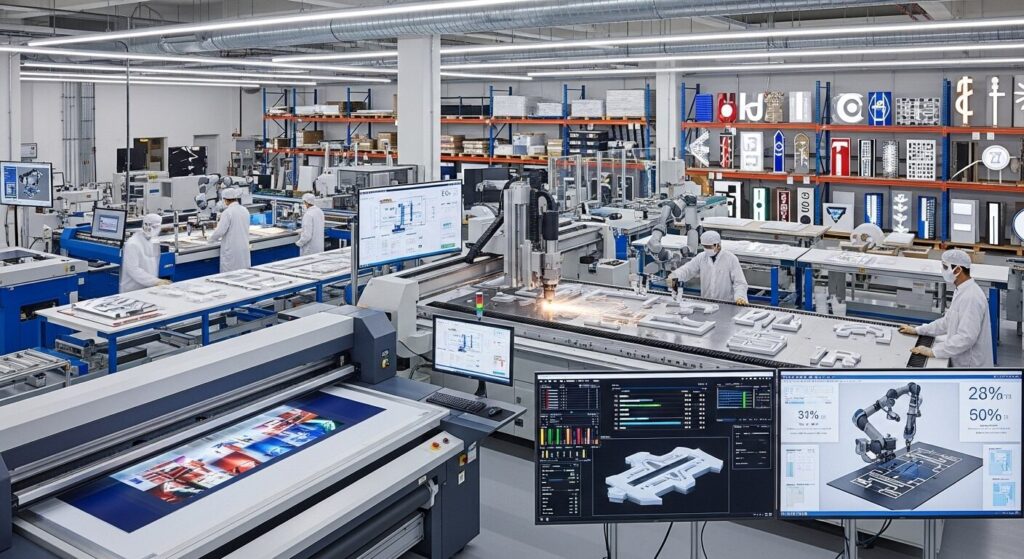
Changes in how business signage is manufactured have enabled new design possibilities while improving quality consistency and reducing production timeframes. These manufacturing evolution affect both cost and capability for businesses considering signage investments.
Digital Manufacturing Techniques have revolutionized production accuracy and customization capabilities. Computer-controlled cutting, precision printing, and automated assembly processes enable complex designs that would have been impossible or prohibitively expensive using traditional manufacturing methods.
3D printing applications are expanding beyond prototyping to include production of custom components, allowing for unique design elements that distinguish businesses from competitors using standard manufacturing approaches.
Quality Control Automation ensures consistency across production runs while reducing defects that previously required rework or replacement. Automated inspection systems identify potential problems during manufacturing rather than after installation.
Standardized quality metrics enable more accurate performance predictions and warranty terms, giving businesses greater confidence in their signage investments while reducing long-term maintenance uncertainty.
Rapid Prototyping Capabilities allow businesses to see and evaluate designs before committing to full production. This capability reduces design risks while enabling more confident decision-making about complex or innovative signage approaches.
Virtual reality design review enables businesses to experience proposed signage in simulated environments, helping identify potential issues or optimization opportunities before manufacturing begins.
Regulatory and Compliance Evolution
Changes in local regulations and industry standards are influencing business sign design approaches, with new requirements addressing accessibility, environmental impact, and community aesthetics. Understanding these regulatory shifts helps businesses avoid compliance issues while leveraging new opportunities.
Accessibility Standards Enhancement requires signage to meet evolving standards for visual impairment accommodation, including contrast requirements, font size specifications, and tactile element integration. These standards affect both new installations and renovation projects.
Digital accessibility requirements are emerging for interactive signage, requiring compatibility with assistive technologies and alternative input methods. Businesses implementing digital signage must consider these requirements during design and programming phases.
Environmental Regulations increasingly affect material selection, energy consumption, and end-of-life disposal considerations for business signage. These regulations influence both design decisions and operational practices throughout the signage lifecycle.
Energy efficiency standards are becoming more stringent, affecting lighting choices and operational parameters for illuminated signage. Businesses must balance visibility requirements with energy consumption limitations.
Economic Factors Driving Change
Economic considerations are influencing business sign design decisions in ways that extend beyond initial cost considerations to include operational efficiency, maintenance requirements, and long-term value optimization.
Total Cost of Ownership Analysis has become standard practice for business signage evaluation. This approach considers initial costs, installation expenses, operational costs, maintenance requirements, and replacement considerations to determine true investment value.
Energy costs particularly influence lighting decisions, with businesses choosing technologies that minimize ongoing operational expenses while maintaining required visibility and impact levels.
ROI Measurement Sophistication enables businesses to track signage performance through customer traffic analysis, sales correlation, and brand recognition metrics. This data helps optimize signage investments while justifying expenses to stakeholders.
Digital signage analytics provide detailed performance data that enables continuous optimization and demonstrates measurable business impact from signage investments.
Frequently Asked Questions About Business Sign Design Changes
How do these design changes affect existing signage installations?
Many current signage installations can be upgraded to incorporate new technologies or materials without complete replacement. LED retrofits, digital element additions, and interactive feature integration often provide cost-effective ways to modernize existing signage while leveraging new capabilities.
What timeline should businesses expect for implementing these new design approaches?
Implementation timelines vary based on complexity and scope. Simple material or technology upgrades might require weeks, while comprehensive redesigns involving new technologies could require several months for design, manufacturing, and installation completion.
How do regulatory changes affect businesses with existing non-compliant signage?
Most regulatory changes include transition periods allowing existing signage to continue operating while requiring compliance for new installations or major renovations. Businesses should consult with signage professionals to understand specific requirements and timeline implications.
Are these design changes suitable for small business budgets?
Many new design approaches offer scalable options that accommodate different budget levels. LED technology costs have decreased significantly, while digital elements range from basic programmable displays to sophisticated interactive systems, allowing businesses to choose appropriate technology levels.
How do these changes affect signage maintenance requirements?
Modern materials and technologies often reduce maintenance requirements while providing better performance monitoring capabilities. Predictive maintenance systems can reduce unexpected failures, while improved materials resist environmental damage that previously required frequent repairs.
What should businesses prioritize when considering these design changes?
Priority should be given to changes that align with specific business objectives, whether those involve customer engagement, operational efficiency, environmental responsibility, or competitive differentiation. Professional consultation helps identify which changes provide the greatest value for specific business situations.
Preparing for Continued Evolution
The pace of change in business sign design shows no signs of slowing, with emerging technologies and evolving customer expectations continuing to drive innovation. Businesses that understand these changes and adapt strategically position themselves for continued success in an evolving marketplace.
Successful adaptation requires balancing current needs with future flexibility, choosing signage solutions that meet immediate requirements while accommodating potential upgrades or modifications as new capabilities become available.
The key to navigating these changes lies in working with signage professionals who understand both current capabilities and emerging trends, ensuring your signage investments align with both current requirements and future opportunities.
Ready to explore how these business sign design changes can benefit your organization? Contact SignLab JAX today to discuss how contemporary design approaches and technologies can enhance your business visibility while preparing for future evolution in the signage industry.

